BREEDING MICE
Breeding mice to exhibit takes a lot of effort but is also very rewarding. Whether you only keep a few mice or have already begun your show career, there is always more to learn. Find out where to start, what to look for in your mice and how to progress with your stock.
Breeding for exhibition
AN INTRODUCTION TO BREEDING
When breeding fancy mice, the usual foundation stock is a trio (or two) of your chosen variety. This comprises a buck and two does. These are mated together when they reach a suitable age (usually around 12 weeks, but this can vary with some varieties doing better if slightly younger). When housing pregnant does, some people keep each doe separate and some prefer to leave two does together. There are risks and benefits associated with each method, and in the end it all comes down to what works best for the fancier and their mice.
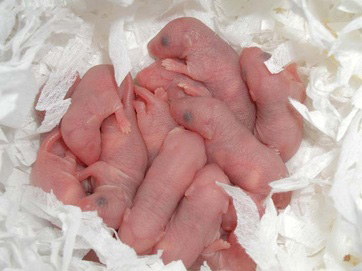
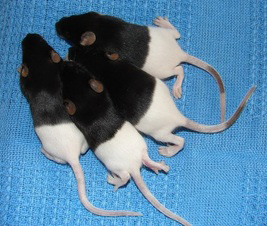
Gestation is approximately 19-21 days for mice. Bucks should be removed before the doe gives birth to avoid reimpregnation just after she gives birth. It is not because bucks will harm their offspring – they’re actually pretty good at keeping the litter warm and so on in their mother’s absence – but because back to back litters can be hard on the doe’s body, and you will usually not achieve good quality litters this way.
Many fanciers use large running on boxes to allow groups of young (weaned) mice to develop before making their final choices of which to keep, show and breed from.
Selection is key
SUCCESSFUL BREEDING
In order to breed high quality mice you must constantly select the best examples from your stud to pass on desired traits to their offspring. There are many things that breeders must consider and balance in their pairings, such as type, size, colour, markings and so on. Choices may also depend on a particular feature you are trying to improve, such as tail set or colour coverage on the feet. No mouse is perfect, so, in general, select for the best all-round candidates; in good condition, healthy, of reasonable type and size and at least a fair example of their variety.
We must also bear in mind that not all breeding animals are fit for the show bench, especially in marked varieties. This does not necessarily mean that they cannot produce winning mice in their litters. In fact, if we only bred from marked mice good enough to show we’d end up losing them altogether relatively quickly!
The selection process starts with the buck and doe to be bred together. Ideally this pair should be good quality stock from established exhibition lines. All being well, approximately three weeks later the doe will give birth to her litter and the fancier’s next round of selection begins.
THE BASICS OF BREEDING
Does
Generally speaking, does can be bred from the age of 12 weeks. Some varieties that tend to become obese and therefore suffer from fertility problems are often bred slightly younger to counteract this – say from ten weeks or so. A doe will give you the best litters when she is still in her prime, so if you are going to breed from a doe then it is advisable not to leave it too long after 12 weeks before her first breeding.
Bucks
Bucks can breed from the age of five weeks or so and remain fertile until they die. Only one buck should be used per cage when mating up, or the bucks will fight over the does. Each buck can be placed with up to three or four does at a time and should be removed when the does are seen to be pregnant and before they give birth.
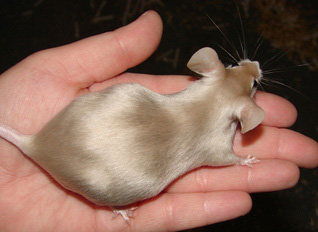
Gestation
Pregnancy in mice lasts 19-21 days.
Litters
Litter size varies with the age of the doe, the variety and particular strain. While mice can have over 20 babies in one litter, the average size is more like 7-12. The young are born without fur and with their eyes and ears closed. The ears will gradually open over the first four days, and the eyes will open at 12 days. Mothers with litters should be kept in solid-sided enclosures to avoid the young escaping. Young ones are weaned at four weeks of age and bucks should be separated from their mother and sisters at this point to avoid pregnancies.
Rebreeding
It is best to give does a break of a week or two after they have weaned their litter before they are bred again. Condition is key however; some does may regain condition quickly and handle gestation again relatively soon, while some may never quite reach their pre-litter fitness again.
But what if… ?
Skills
SEXING MICE
Sexing mice is one of the most important skills to learn if you are serious about breeding or keeping large numbers of mice. You need to be able to identify and remove unwanted bucks from the nest at only a few days old, as well as to separate baby bucks from their mother and sisters at four to four and a half weeks old to prevent them impregnating the does.
Females (does)
Female mice are known as does. They have ten nipples that they use to feed their litter until it is fully weaned at around four weeks. The nipples can be seen when a doe is nursing (at other times they are usually covered reasonably well by the belly fur) and are a good way to identify female mice since males do not have nipples. Nipples are most visible in young mice or in does who have had a litter. If the nipples are not obvious then you must rely on checking the mouse’s genitals alone to sex it. A female mouse’s vagina is close to its anus, with little space in between the two.
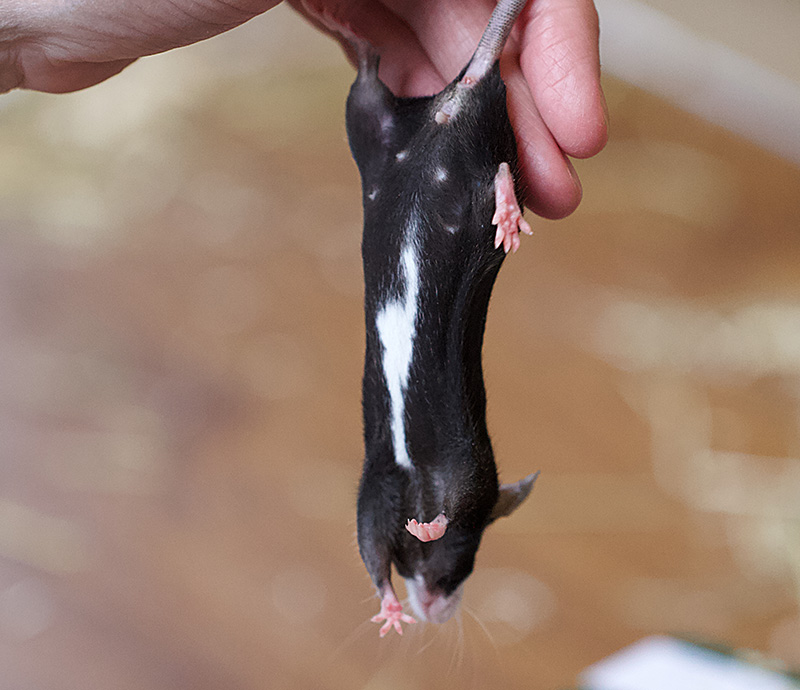
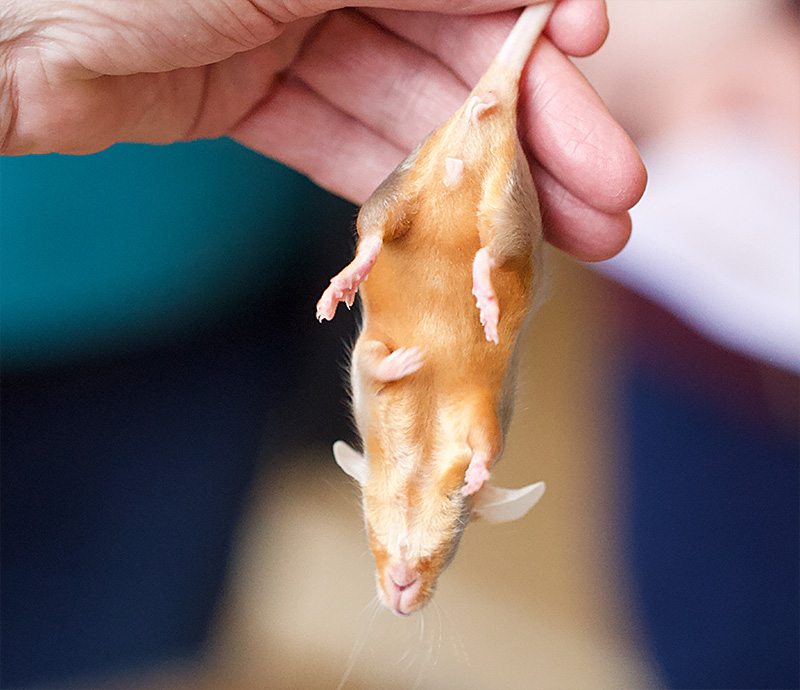
Males (bucks)
Male mice are called bucks. They do not have nipples, but just because you cannot see a mouse’s nipples does not mean they are not there. If a buck is old enough to leave its mother (four weeks or older) then it should have fairly obvious testicles. Mice have large testicles in comparison to their body size, which will ‘drop’ as the mouse matures into adolescence.
Mice can retract their testicles into their body, so they may be there even though they are not totally obvious. If you are unsure there are several ways to deal with this. A simple way is to give the mouse a high sided food bowl to eat from and watch it perch on the side – if it has testicles they should drop at this point for you to observe. Alternatively, when you lift the mouse to inspect underneath, you may still be able to see the slightly baggy scrotum even if the mouse is retracting its testicles. This is more obvious in older mice who are fully developed. You should also check the anogenital distance. The distance between the anus and the genitals of a male mouse is larger than it is in a female mouse. If you compare the two you will see that while the female’s anus and vagina appear almost joined, the male’s penis is spaced quite far apart from the anus.
Babies
Lots of beginners find it difficult to sex baby mice, but all you need is a bit of practice – and ideally someone to show you how. Below are some photos of pinkies and furred babies that may help
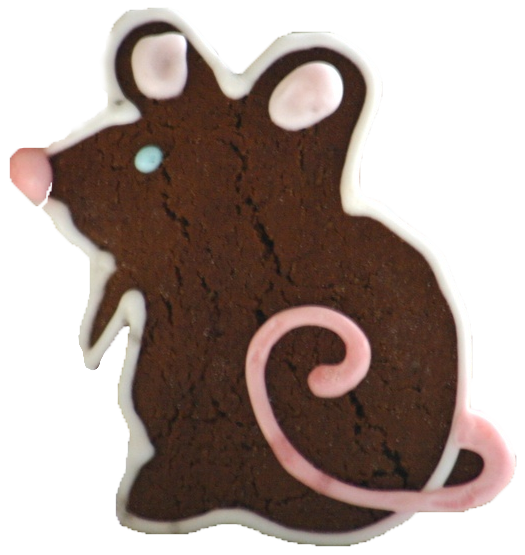 We use cookies to ensure that we give you the best experience on our website. If you continue to use this site we will assume that you are happy with it.
We use cookies to ensure that we give you the best experience on our website. If you continue to use this site we will assume that you are happy with it.